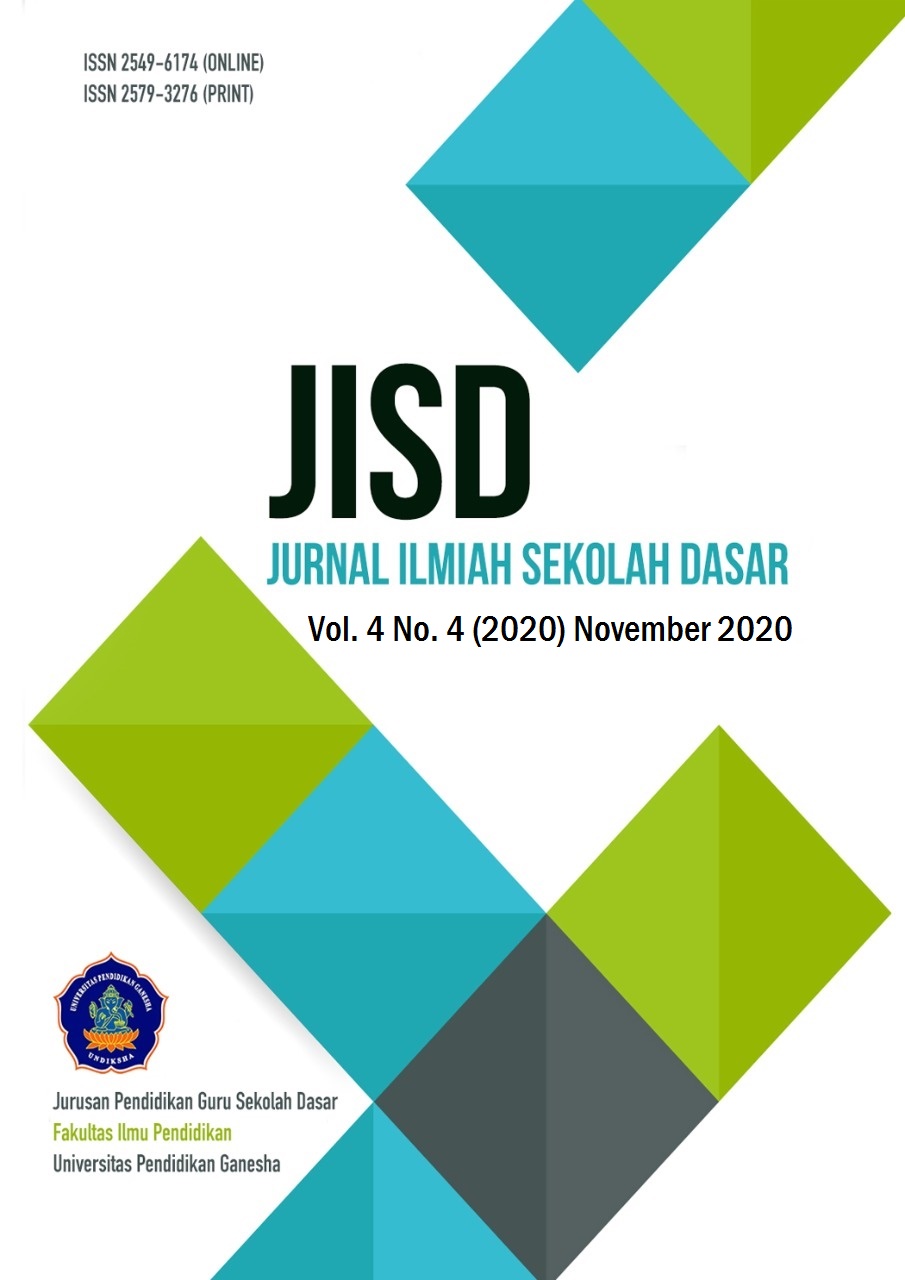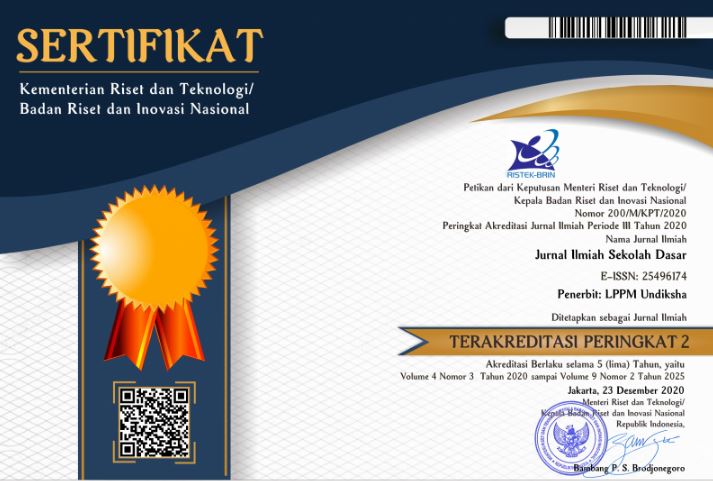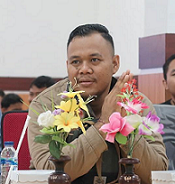Improving Spelling Learning in Primary School Age through Songs
DOI:
https://doi.org/10.23887/jisd.v4i4.28584Keywords:
song, spelling learning, children of elementary school ageAbstract
English needs to be taught from an early age, at the basic education level. Teachers in elementary schools are required to provide an interesting and easy-to-understand English learning experience for students. However, the problem is that not all teachers in elementary schools have that ability. Only a few teachers can create learning English creatively. One of them is a teacher at Kramat Elementary School, Kudus Regency. The teacher at the elementary school taught English on spelling learning material through the media of songs. This research aimed to examine in depth the use of song media to increase elementary school-aged children's spelling learning. This research is qualitative, aiming to deepen the study of spelling learning for elementary school-aged children and their solutions to globally improve the quality of primary school education. This research's object is the teachers and students of SDN Kramat, Kudus Regency with the data collecting technique of observation, interviews, and documentation. The data obtained is then analyzed using Miles & Huberman (1992) analysis technique, including activities of reduction, data presentation, and conclusion/verification. The results showed that the use of songs in learning English, especially spelling learning in elementary schools, was able to have a positive impact on both teachers and students. The impact for teachers is to provide awareness that creativity is something important for them to improve professionalism. For students, the song is an effective medium to increase learning motivation and understand the material. The conclusion in this study is that the use of song media in spelling learning impacts teacher creativity and increases elementary school students' English learning outcomesReferences
Ameliah, I.H., Munawaroh, M., & Muchyidin, A. (2016). Pengaruh Keingintahuan dan Rasa Percaya Diri Siswa terhadap Hasil belajar Matematika Kelas VII MTs Negeri I Kota Cirebon. EduMa, 5(1), 9–21. Retrieved from https://www.neliti.com/id/publications/55886/pengaruh-keingintahuan-dan-rasa-percaya-diri-siswa-terhadap-hasil-belajar-matema
Bayu, G. W., Dibia, I. K., Yudiana, K., Agustika, G. N. S., & Jayanti, L. S. S. W. (2019). Pemetaan Kompetensi Inti (KI) Dan Kompetensi Dasar (KD) Mata Pelajaran Bahasa Inggris Sekolah Dasar Berbasis Kurikulum 2013. Seminar Nasional Pengabdian Kepada Masyarakat, 4, 622–626.
Butler, Y. G. (2004). What level of English proficiency do elementary school teachers need to attain to teach EFL? Case studies from Korea. TESOL Quarterly, 245–278.
Evertson, C. M. (1994). Classroom management for elementary teachers. Allyn & Bacon, A Division of Simon & Schuster, Inc., 160 Gould Street, Needham Heights, MA 02194.
Grossman, Pamela L., Peter Smagorinsky, and S. V. (1999). Appropriating tools for teaching English: A theoretical framework for research on learning to teach. American Journal of Education, 108(1), 1–29.
Iswari, F. (2017). Pengembangan Media Pembelajaran Bahasa Inggris Berupa Flashcard Bergambar pada Tingkat Sekolah Dasar. DEIKSIS, 9(2), 119–128.
Jumaryatun. Slamet Mulyono dan Atikah Anindyarini. (2014). Penggunaan Media Lagu Sebagai Upaya Meningkatkan Motivasi dan Kemampuan Dan Menulis Cerpen. Jurnal Penelitian Bahasa, Sastra Indonesia Dan Pengajarannya, 1(3). Retrieved from https://media.neliti.com/media/publications/53135-ID-penggunaan-media-lagu-sebagai-upaya-meni.pdf
Kang, D.-M. (2018). The classroom language use of a Korean elementary school EFL teacher: Another look at TETE, 36(2), 214–226.
Kustandi, C. & Sutjipto, B. (2013). Media Pembelajaran Manual dan Digital. Bogor: Ghalia Indonesia.
Lee, J.-A. (2009). Teachers’ sense of efficacy in teaching English, perceived English language proficiency, and attitudes toward the English language: A case of Korean public elementary school teachers. Diss: The Ohio State University.
Madya, Suwarsih, et al. (2004). Developing a model of teaching English to primary school students. Teflin Journal, 15(2), 193–229.
Maili, S. N. (2018). Bahasa Inggris Pada Sekolah Dasar : Mengapa Perlu Dan Mengapa Dipersoalkan. Jurnal Pendidikan UNSIKA, 6(1), 23–28.
Miles dan Huberman. (1984). Qualitative Data Analysis: A Sourcebook of New Methods. California: Sage Publication Inc.
Moleong, L. J. (2001). Metode Penelitian Kualitatif. Bandung: Remaja Rosdakarya.
Muhson, A. (2010). Pengembangan Media Pembelajaran Berbasis Teknologi Informasi. Jurnal Pendidikan Akuntansi Indonesia, 8(2), 1–10. Retrieved from https://journal.uny.ac.id/index.php/jpakun/article/view/949/759
Muid, A. (2015). Pentingnya Bahasa Inggris dan Bahasa Arab pada KurikulumPendidikan. Jurnal Ilmu Pendidikan Islam, 14(2), 32–42.
Ratminingsih. (2016). Efektivitas Media Audio Pembelajaran Bahasa Inggris Berbasis Lagu Kreasi di Kelas 5 Sekolah Dasar. Jurnal Pendidikan Indonesia, 5(1), 27–38. https://doi.org/10.23887/jpi-undiksha.v5i1.8292
Roffiq, A. (2017). Media Musik Dan Lagu Pada Proses Pembelajaran. Jurnal Pendidikan Dasar Indonesia, 2(2), 35–40. Retrieved from https://journal.stkipsingkawang.ac.id/index.php/JPDI/article/view/330/393
Spradley, J. P. (2016). Participant observation. Waveland Press.
Supriyono, Y., Dewi, N. S. N., & Ruslan, R. (2017). Pembelajaran Bahasa Inggris Berbasis E-Learning Untuk Guru-Guru Kkm Di Lingkungan Kemenag Kabupaten Tasikmalaya. Jurnal Pengabdian Siliwangi, 3(1).
Tafonao, T. (2018). Peranan Media Pembelajaran Dalam Meningkatkan Minat Belajar Mahasiswa. Jurnal Komunikasi Pendidikan, 2(2). Retrieved from http://journal.univetbantara.ac.id/index.php/komdik/article/view/113/101
Yassaei, S. (2012). Using Original Video and Sound Effects to Teach English. ERIC, 50(1), 12–16. Retrieved from https://eric.ed.gov/?id=EJ971236
Downloads
Published
How to Cite
Issue
Section
License
Authors who publish with the Journal Ilmiah Sekolah Dasar agree to the following terms:
- Authors retain copyright and grant the journal the right of first publication with the work simultaneously licensed under a Creative Commons Attribution License (CC BY-SA 4.0) that allows others to share the work with an acknowledgment of the work's authorship and initial publication in this journal.
- Authors are able to enter into separate, additional contractual arrangements for the non-exclusive distribution of the journal's published version of the work (e.g., post it to an institutional repository or publish it in a book), with an acknowledgment of its initial publication in this journal.
- Authors are permitted and encouraged to post their work online (e.g., in institutional repositories or on their website) prior to and during the submission process, as it can lead to productive exchanges, as well as earlier and greater citation of published work. (See The Effect of Open Access)










